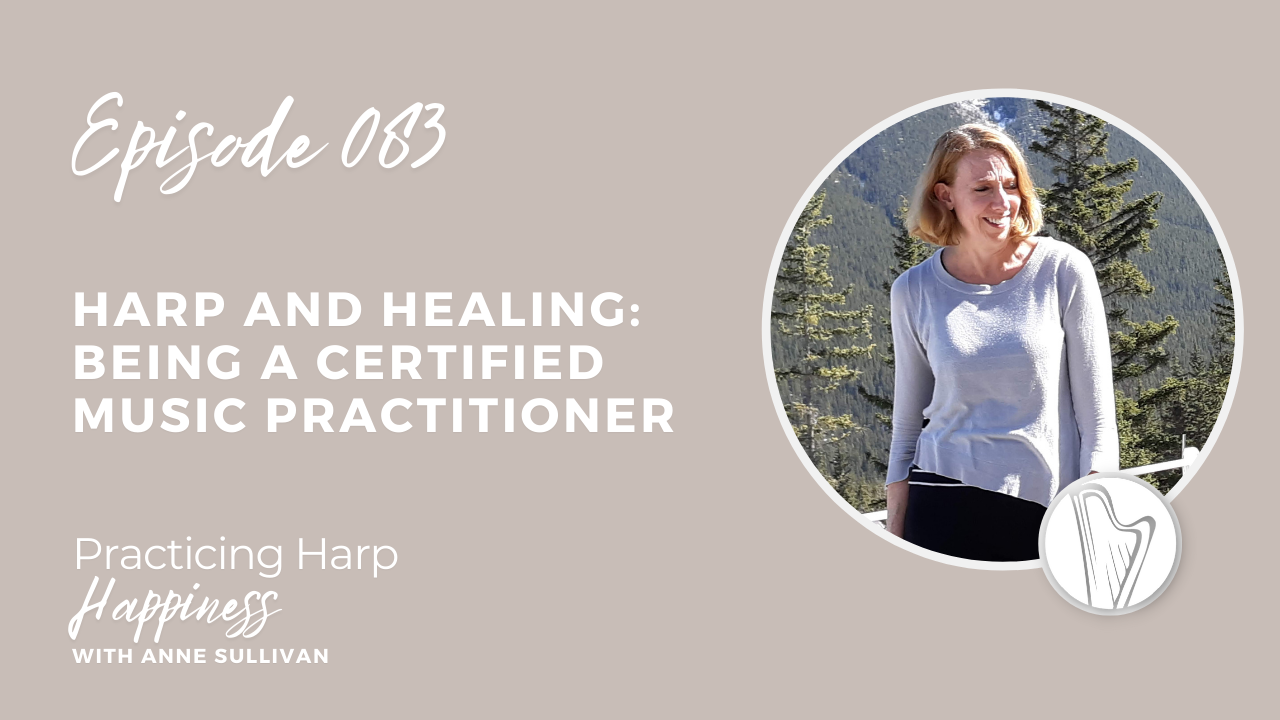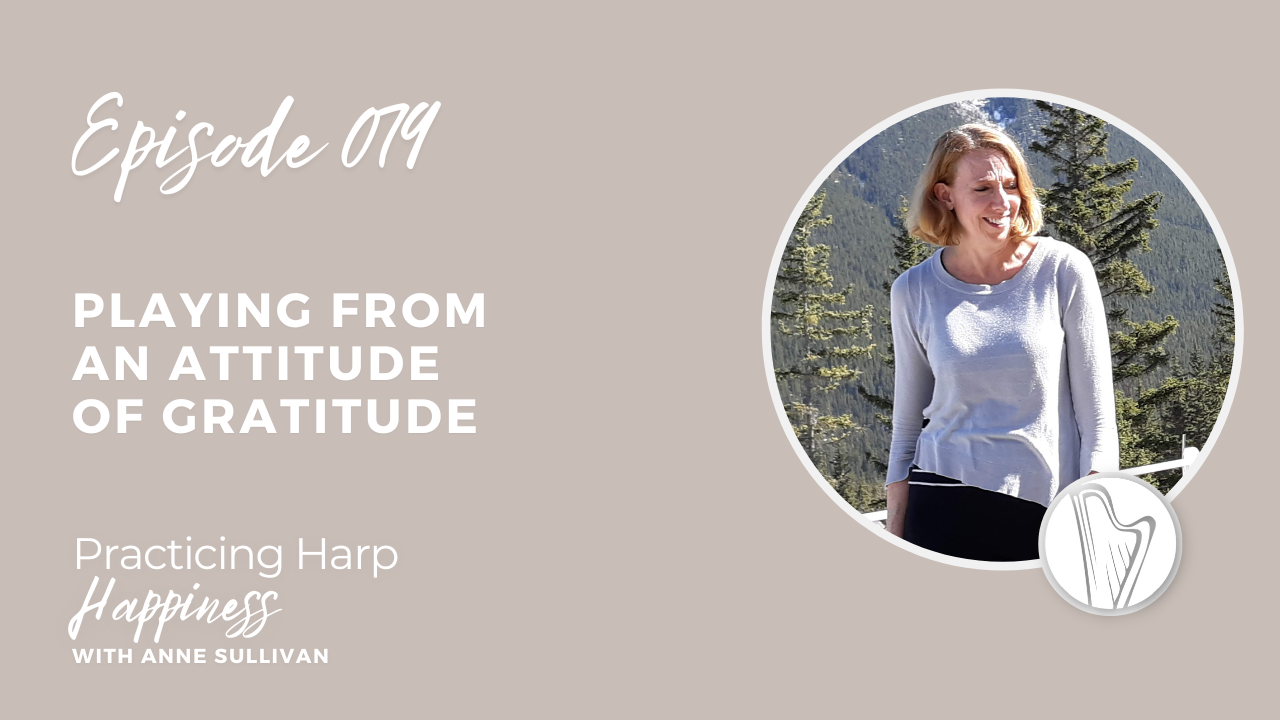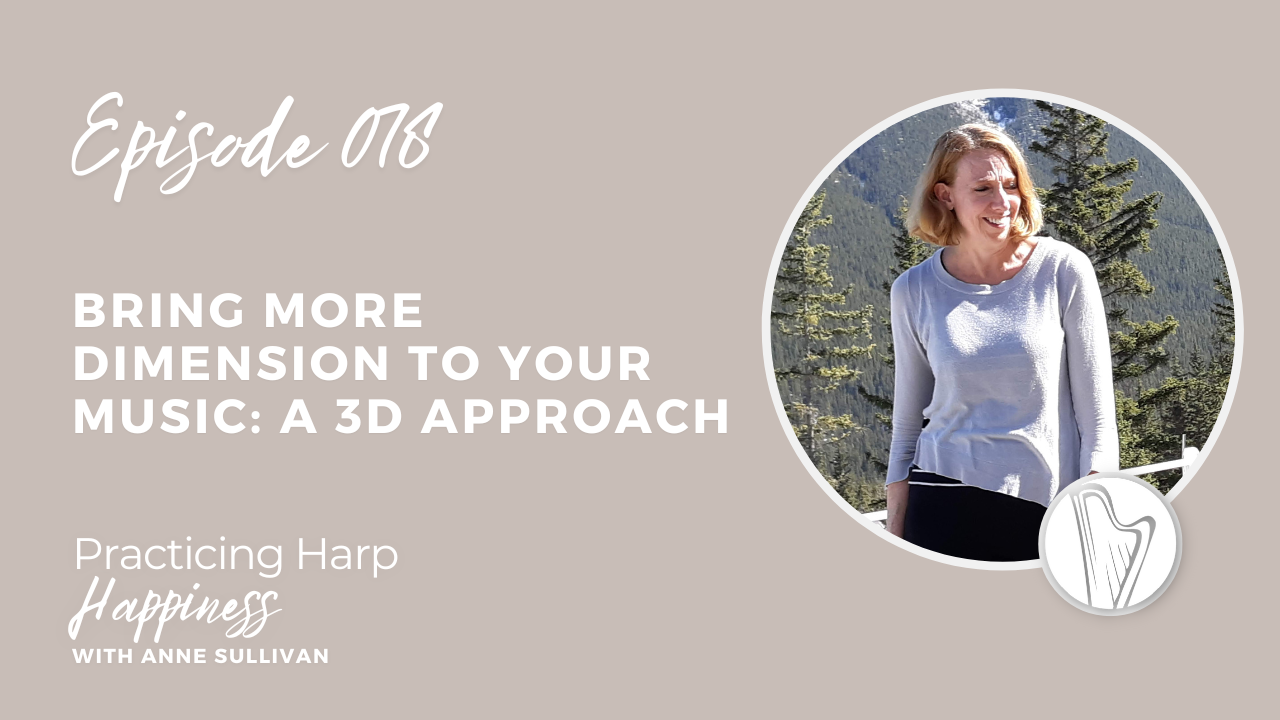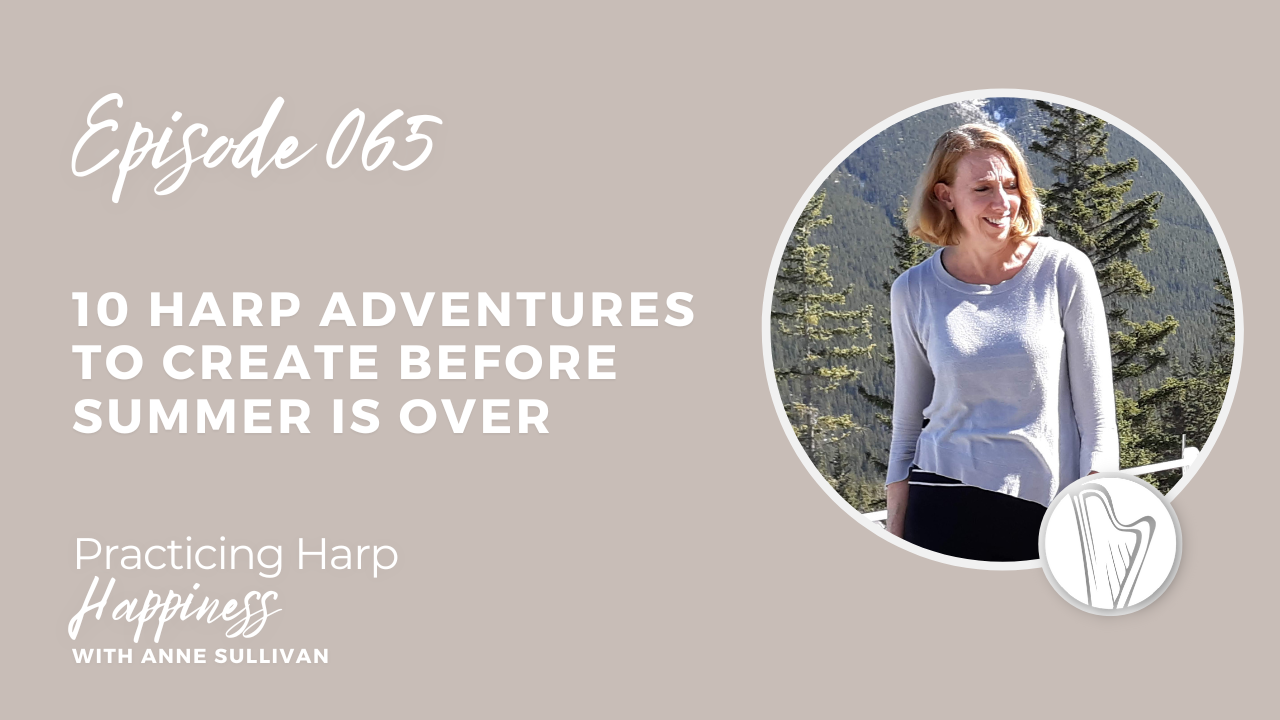Practicing Harp Happiness
#083: Harp and Healing: Being A Certified Music Practitioner

If you’ve ever marveled at the healing power of music, then this podcast episode will blow your mind.
This week I will share with you a conversation with a special guest, harpist Barbara Lepke-Sims. Barbara is a Juilliard trained harpist and an expert teacher and performer, and one of the main facets of her playing is as a music practitioner. She doesn’t just call herself a music practitioner; she is certified through the Music for Healing and Transition program and has more than a decade of experience bringing healing and peace to those who suffer.
I met Barbara when I became a board member of the American Harp society, where she has been very active, but we really connected when we met up at the World Harp Congress in Wales this summer. I was curious about how she became a music practitioner, why she chose the certification program she did and what really motivates her about this important work.
I was really picking her brain because this is a field where I have little direct...
#082: Time for a Refresh: Why This is the Time to Think Different

Do you remember that famous Apple computer advertising campaign, the one that urged us all to “think different?”
That ad campaign was created just after Steve Jobs had returned to the Apple company and Apple needed a new start. The year was 1997 and Apple was on the rocks. Their stock was trading at a 12-year low, and the company that had been known for its creativity and innovation was stagnant and dying. So when Steve Jobs returned to Apple after having left in the mid-1980s, customers, if not Apple’s board of directors, were expecting something new and exciting. And they got it, with interest. During Jobs' tenure after his return, Apple launched the iMac, iBook, iPod, Mac OS X, iPhone, iPad, and more.
You may have forgotten that shaky period in Apple’s history, but I bet the ad campaign is still fresh in your mind.
There were two television advertisements that were shown most often. There was a one-minute version that featured black-and-white images of 17 iconic 20th-centur...
#079: Playing from an Attitude of Gratitude

This Thursday we will celebrate Thanksgiving here in the U.S. and it’s a big deal for us. According to a recent survey Thanksgiving edges out all other holidays, including Christmas, ranking as our most popular holiday. It’s really about three things: food, family and football. Oh right. It’s about being thankful too.
We try to be more intentional about keeping an “attitude of gratitude” at this time of year, but it isn’t easy. Thanksgiving also is the official kick off for the holiday shopping season, so the thankfulness is often tinged with a touch of frenzy as the Black Friday sales begin.
I’m sure you’re receiving plenty of reminders to be thankful this Thanksgiving but I wanted to add a special harp-themed reminder.
My idea actually grew out of the Play It With Confidence Intensive from just a few weeks ago. We spent a lot of time in that course talking about mindset and choosing what matters to us in our playing. For me and for many of our Intensive participants, that mind...
#078: Bring More Dimension To Your Music: A 3D Approach

I am fascinated with 3D printers. I don’t have one and I don’t see that I will ever need to have one, although we would have said the same about a smartphone just a few years ago. The idea, though, that a computer file, which seems less than tangible to begin with, can be turned into a solid three-dimensional object fascinates me, And 3D printing is used virtually everywhere: to produce eyeglasses and furniture, scale models, medical devices, reconstruction of ancient artifacts, and the list goes on.
The process is also interesting. It requires special software to read the design file and slice it into hundreds or thousands of cross-sections of the end product which are then created one by one until the end product is complete.
What I find so intriguing is that the process is an additive process where the slices are added together to create the object. Consider how this is the reverse of more traditional processes where material is taken away, or subtracted, from an initial block...
#068: Mindset Reset: Keeping the Play in Your Playing

Today is Labor Day in the United States. The very first Labor Day was celebrated exactly 140 years ago today on September 5, 1882. It was intended as a holiday for the general working population in recognition of their contributions to the country’s prosperity and strength. At that time it was decided that the celebrations should include a parade to showcase the trade and labor unions and a picnic for the workers and their families.
Today, 140 years later, Labor Day celebrations still include parades and picnics. Labor Day also marks the traditional end of summer holidays and the beginning of a new school year.
The idea of Labor Day - to celebrate and honor work and toil - is a powerful one, and one that I would like to suggest has application to our harp playing. That’s the key word - playing.
We work so hard to make our playing what we want it to be, what we think it should be. By contrast, how much time do we take to celebrate our hard work or even to simply enjoy playing th...
#065: 10 Harp Adventures To Create Before Summer Is Over

Summer is flying by for me, and I imagine for you too. I always make big plans for the summer. I tell myself that this is the summer I will start my Christmas music early or seriously work on my technique or get that recital program memorized. But no matter how good my intentions are, the summer just seems to slip through my fingers without anything to show for it other than a sunburn. It can feel pretty disheartening.
Let’s turn this around for a minute. What if this were the summer that I really enjoyed my harp playing? Not worked hard at it or put pressure on myself to get to that next level or learn that big piece, but just enjoyed it. I’m feeling the harp happiness buzz already.
I hope that sounds good to you too because on today’s show I’m going to share 10 of my favorite ways to create adventure in your summer harp playing - that’s right, adventure.
Your music could be a time machine taking you to a distant place and time. It could be a magic carpet for traveling to far o...
#062: Your Guide to Perfect Octaves

Octaves are everywhere. There are very few harp pieces that don’t include octaves somewhere, and with good reason. Octaves add richness to a left hand accompaniment or to a right hand melody. The added resonance of the string played an octave lower or higher makes the entire harp come alive with sound.
We harpists love octaves and we play them all the time. So why are they often the hardest intervals to play well?
You know what I mean. Your thumb plays two strings at once, or your fourth finger brushes the surrounding strings, making your octave sound like a cluster of sound rather than a clear, clean interval. Sometimes they are hard to place accurately and our fingers buzz or just play the wrong notes.
It’s time to go back to basics, my friends. Don’t feel discouraged; this is what we all do from time to time when a fundamental part of our technique isn’t working. It’s not a failure. It’s merely a coordination we need to refresh. Often giving our fingers a gentle reminder of...
#061: Masterclass: Making Sense of Meter Signature Changes

Has this ever happened to you? You’re sailing along, playing through a new piece. You’re feeling pretty good because the piece is actually flowing along. You can tell you’ve been making progress because a year or so ago, this piece would have felt difficult.
Just about the time you’re ready to pat yourself on the back and imagine yourself tackling that piece you’ve always thought was too hard, your playing comes to a screeching halt. There’s a new meter signature, or time signature, in front of you. Your easy piece in 4/4 time suddenly has a measure of ⅞. What the heck is this about??
On today’s show, we’re going to find out exactly what meter changes like that imaginary one are all about. While we often associate them with contemporary music, changing meters have been a part of music since music began. If you play traditional folk music, you encounter meter changes all the time. In fact, the meter signature is a relatively recent invention.
This is a masterclass-style podcast...
#055: Overcoming Fears, Doubt and Misgivings: Take the Long View

What have you done lately that was courageous?
I hope you shouted your answer, said it loud and proud.
Okay, now answer this one.
What would you have done recently if you hadn’t been so fearful?
That’s not exactly a “loud and proud” moment. But we all do it; we let our fears, our doubts, our nerves get the better of us.
Talk to any person who is super-successful in their field and they’ll confess to having their insecurities, their own sleepless nights worried about the decisions they’ve made or not made. Most people aren’t fearless. But successful people have learned that many times fear is the only barrier between their present and their future. Success comes only when they are able to go through the fear to discover what lies beyond it.
I often talk and write about how to find the courage and the confidence to share your music. You may call it “performing,” but at Harp Mastery® we call it ”sharing your music.” Whatever you call it though, you still might feel your palms sweating an...
#054: An American Romantic:The Music of Stephen Foster for Harp

Stephen Foster is often referred to as the “Father of American music,” or “America’s first songwriter,” neither of which is strictly true. However, Stephen Foster’s extensive output of songs and the strength of their popularity more than 150 years later attests to the powerful connection his music creates. The homespun appeal of his words and music evokes gentle images of family, home, love and longing that are in sharp contrast to his more difficult reality.
In fact, there were many ironical contradictions between his music and his life. His songs paint vivid pictures of life in the South, but Foster never lived there and only visited there once. HIs music was a staple in music hall minstrel shows, but Foster himself was an ardent abolitionist. His life came to a close not with the “Old Folks at Home” but alone in Bellevue Hospital in New York City.
Nonetheless, his music is filled with singable melodies, uncomplicated harmonies and a romantic sentiment that not only still touc...

